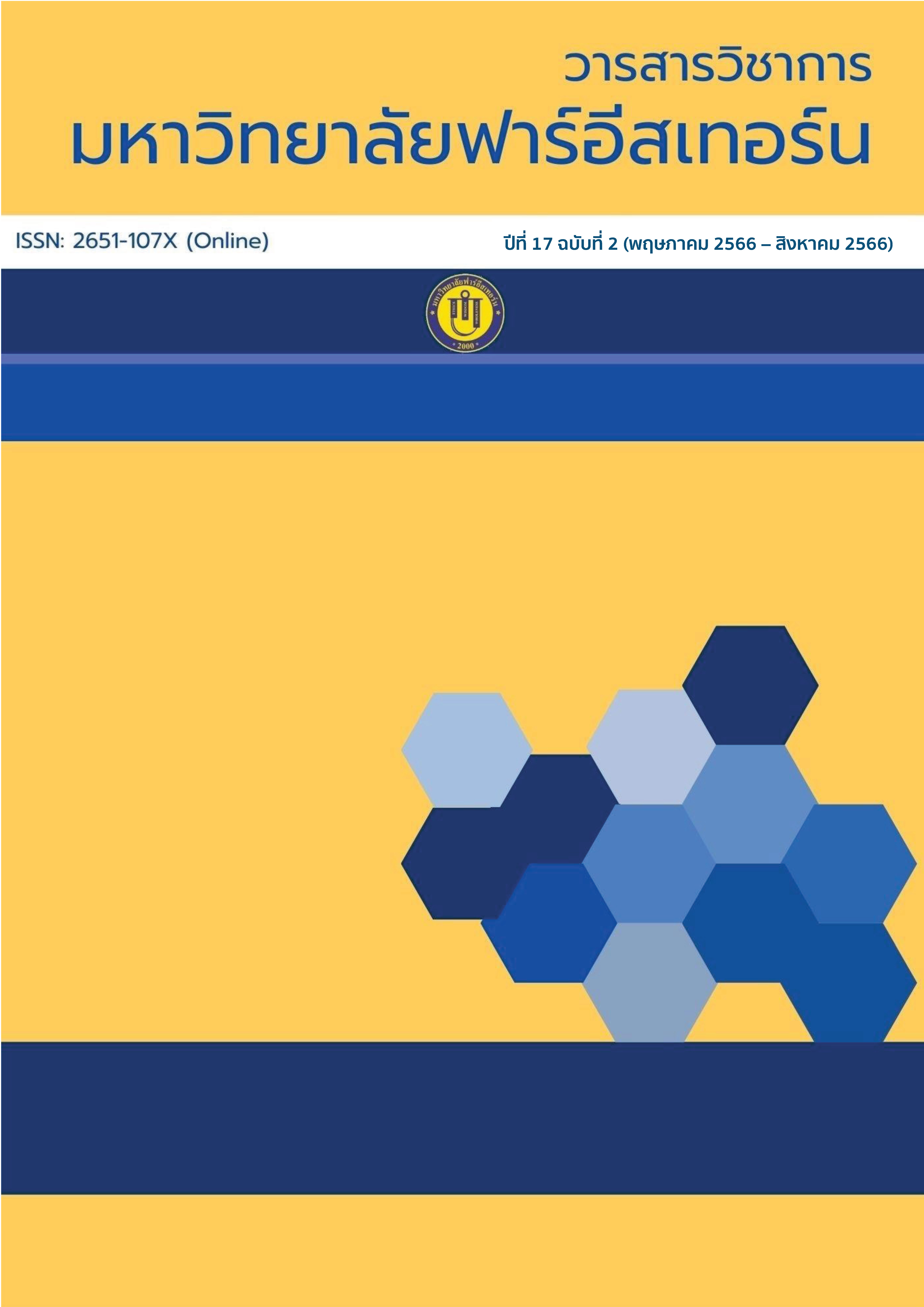การวิเคราะห์องค์ประกอบเชิงยืนยันชื่อเสียงประเทศไทย
Main Article Content
บทคัดย่อ
งานวิจัยนี้มีวัตถุประสงค์ 1) เพื่อวิเคราะห์องค์ประกอบเชิงยืนยันชื่อเสียงประเทศไทย 2) เพื่อตรวจสอบความสอดคล้องของแบบจำลองคุณลักษณะของชื่อเสียงประเทศไทย เป็นงานวิจัยเชิงปริมาณ โดยใช้แบบสอบถามในการเก็บข้อมูลจากกลุ่มตัวอย่าง จำนวน 800 คน จากประชาชนชาวไทย ด้วยการจับสลากตัวแทนจังหวัดตามภูมิภาค 4 ภาค ได้แก่ จังหวัดเชียงใหม่ จังหวัดลำปาง จังหวัดอุบลราชธานี จังหวัดนครพนม จังหวัดพิษณุโลก จังหวัดปทุมธานี จังหวัดสุราษฎร์ธานี จังหวัดกระบี่ และเจาะจงเลือกตัวอย่างพื้นที่พิเศษในกรุงเทพมหานคร โดยใช้แบบสอบถามที่มีค่าความเชื่อมั่น 0.824-0.936 วิเคราะห์ข้อมูลสถิติพรรณนาด้วยโปรแกรมสถิติทางสังคมศาสตร์และการวิเคราะห์องค์ประกอบเชิงยืนยันด้วยโปรแกรมริสเรล พบว่า ชื่อเสียงประเทศไทยโดยรวมทุกด้านอยู่ในระดับปานกลาง เมื่อพิจารณาเป็นรายด้าน ด้านวัฒนธรรมมีค่าเฉลี่ยสูงสุด อยู่ในระดับมาก รองลงมา คือ ด้านกายภาพ อยู่ในระดับมาก เมื่อปรับแบบจำลองจนมีความสอดคล้องกับข้อมูลเชิงประจักษ์มีค่า ไค-สแควร์ (x2) มีค่า 591.78; df=220; p-value=0.00; RMSEA=0.044; RMR=0.034; SRMR=0.040; GFI=0.96; CFI=1.00 โดยองค์ประกอบที่สามารถบ่งชี้ชื่อเสียงประเทศไทยได้มากที่สุด คือ ด้านความเป็นผู้นำ ร้อยละ 98 (R2=0.98, b=0.92) รองลงมา คือ ด้านสังคม ร้อยละ 97 (R2=0.97, b=1.03) ลำดับที่ 3 คือ ด้านความปลอดภัย ร้อยละ 87 (R2=0.87, b=0.96)
Article Details

This work is licensed under a Creative Commons Attribution-NonCommercial-NoDerivatives 4.0 International License.
1. ทัศนะและข้อคิดเห็นใดๆ ในวารสารวิชาการมหาวิทยาลัยฟาร์อีสเทอร์นเป็นทัศนะของผู้เขียน กองบรรณาธิการไม่จำเป็นต้องเห็นพ้องด้วยกับทัศนะเหล่านั้นและไม่ถือว่าเป็นความรับผิดชอบของกองบรรณาธิการ
2. ความรับผิดชอบด้านเนื้อหาและการตรวจร่างบทความแต่ละบทเป็นของผู้เขียนแต่ละท่าน กรณีมีการฟ้องร้องเรื่องการละเมิดลิขสิทธิ์ถือเป็นความรับผิดชอบของผู้เขียนแต่เพียงฝ่ายเดียว
3. ลิขสิทธิ์บทความเป็นของผู้เขียนและมหาวิทยาลัยฟาร์อีสเทอร์นได้รับการสงวนสิทธิ์ตามกฎหมาย การตีพิมพ์ซ้ำต้องได้รับอนุญาตโดยตรงจากผู้เขียนและมหาวิทยาลัยฟาร์อีสเทอร์นเป็นลายลักษณ์อักษร
References
การท่องเที่ยวแห่งประเทศไทย. (2563). การศึกษาแนวโน้มและทิศทางการท่องเที่ยวไทยในปี พ.ศ.2563. กรุงเทพมหานคร: กองวิจัยการตลาด การท่องเที่ยวแห่งประเทศไทย.
ณัฐวิชช์ ดำรงศรีวงศ์. (2564). พัฒนาการลักษณะการมีส่วนร่วมทางการเมืองของประชาชน. วารสารวิชาการไทยวิจัยและการจัดการ, 2(1), 61-71. https://so05.tci- thaijo.org/index.php/TRDMJOPOlSU/article/view/252039
นันทินี สันติธรรม. (2560). การนำเสนอภาพของศิลปวัฒนธรรมไทยผ่านละครโทรทัศน์ [วิทยานิพนธ์ปริญญามหาบัณฑิต, มหาวิทยาลัยธรรมศาสตร์]. http://ethesisarchive.library.tu.ac.th/thesis/2017/TU_2017_5907011471_8184_9151.pdf
ประสิทธิ์ ปิวาวัฒนพานิช. (2562). แนวทางการพัฒนากฎหมายให้สอดคล้องกับหลักสากลตามบทบัญญัติของรัฐธรรมนูญ (บทสัมภาษณ์ความเห็นทางวิชาการ). จุลนิติ, 16(2), 3-11.https://library.senate.go.th/document/Ext21733/21733771_0002.PDF
พระครูปลัดประวิทย์ วรธมฺโม, พระครูใบฎีกาศักดิ์ดนัย สนฺตจิตฺโต และ สัญญา สดประเสริฐ. (2564). การนำหลักธรรมาภิบาลมาใช้กับการบริหารงานภาครัฐ. วารสารมหาจุฬานาครทรรศน์, 8(4), 35-47.https://so03.tci-thaijo.org/index.php/JMND/article/view/251622
เสกสรรค์ สนวา, สุพัฒนา ศรีบุตรดี, พงศ์สวัสดิ์ ราชจันทร์ และ นภัสภรณ์ ภูวตานนท์ ณ มหาสารคาม. (2563). การจัดการแหล่งท่องเที่ยวเชิงวัฒนธรรมตามวิถีชีวิตของคนในชุมชน. วารสารการบริหารการปกกครองและนวัตกรรมท้องถิ่น, 4(1), 259-276. https://so03.tci-thaijo.org/index.php/JLGISRRU/issue/view/16423
เสรี ชัดแช้ม. (2547). การวิเคราะห์องค์ประกอบเชิงยืนยัน. วารสารวิจัยและวัดผลการศึกษา, 2(1), 15-42.
อุดม ไพรเกษตร และ ปิยากร หวังมหาพร. (2560). การมีส่วนร่วมของประชาชนผ่านทางสื่อสังคมเฟสบุ๊คของหน่วยงานภาครัฐ. วารสารการเมืองการปกครอง, 7(1), 39-59. https://so03.tci-thaijo.org/index.php/jopag/article/view/147534
Berens, G., Fombrun, C.J., Ponzi, L.J., Trad, N.G. & Nielsen, K. (2011). Country RepTrak™: A Standardized Measure of Country Reputation. In: Go, F.M., Govers, R. (Eds.) International Place Branding Yearbook 2011. Palgrave Macmillan, London.
Country RepTrak. (2012). 2012 Country RepTrak™ Top line Report. www.tfsa.ca/storage/reports/2012_Country_RepTrak_Topline_Report.pdf
Christelis, D. (2006). Country reputation management: Identifying the drivers of South Africa’s reputation in German media [Master’s Thesis, University of Stellenbosch].
Frobes. (2019). The World’s Most Reputable Countries 2019.https://www.forbes.com/sites/vickyvalet/2019/10/15/the-worlds-most-reputable-countries-2019/?sh=4bfac95f4cb8
Fullerton, J. & Holtzhausen, D. (2012). Americans’ attitudes toward South Africa: a study of country reputation and the 2010 FIFA World Cup. Place Branding and Public Diplomacy, 8(4), 269-283.https://link.springer.com/article/10.1057/pb.2012.19
Hooper, D., Coughlan, J. & Mullen, M. (2008). Structural equation modeling: guidelines for determining model fit. Electronic Journal of Business Research Methods, 6(1), 53-60.https://www.researchgate.net/publication/254742561_Structural_Equation_Modeling_Guidelines_for_Determining_Model_Fit
Jain, R. & Winner, L. (2013). Country reputation and performance: The role of public relations and news media. Place Branding and Public Diplomacy, 9(2), 109–123. DOI:10.1057/pb.2013.7
Kelley, J., Hemphil, A. & Thams, Y. (2019). Corporate social responsibility, country reputation and corporate reputation: A perspective on the creation of shared value in emerging markets. Multinational Business Review, 27(2), 178-197. https://doi.org/10.1108/MBR-07-2017-0047
Kiambi, D. & Shafer, A. (2018). Country reputation management: Developing a scale for measuring the reputation of four African countries in the United States. Place Branding and Public,14(3), 175–186. https://link.springer.com/article/10.1057/s41254-017-0065-7
Marino, V. & Mainolfi, G. (2013). Country reputation and attitudes towards made in Italy products: a study on Chinese consumers. International journal of Chinese culture and management, 3(3), 228-241.https://doi.org/10.1504/IJCCM.2013.055420
Newburry, W. (2012). Waving the flag: the influence of country of origin on corporate reputation. The Oxford Handbook of Corporate Reputation.
Reputation institute. (2023). Global RepTrak™ 100. https://www.reptrak.com/
Szwajca, Danuta. (2017). The Importance of Reputation of A Country in the Process of Building its Competitive Advantage on The Global Market. Scientific Journal, 21(7), 99-114.https://asej.eu/index.php/asej/article/view/437
Yang, Sung-Un; Shin, Hochang; Lee, J. H. & Wrigley, B. (2008). Country Reputation in multidimensions: Predictors, Effects, and Communication Channels. Journal of Public Relations Research, 20(4), 421-440.https://doi.org/10.1080/10627260802153579
Yousaf, S. (2017). Quantification of country images as stereotypes and their role in developing a nation brand: The case of Pakistan. Place Branding and Public Diplomacy, 13(1), 1-15.https://link.springer.com/article/10.1057/pb.2015.22
Yousaf, S. & Li, H. (2015). Social identity, collective self-esteem and country reputation: the case of Pakistan. Journal of Product & Brand Management, 24(4), 399-411. https://doi.org/10.1108/JPBM-04-2014-0548
Yousaf, S. & Samreen, N. (2015). Information agents and cultural differences as determinants of country’s reputation and its subsequent effects on tourism prospects of a country in sustained crises: The case of Pakistan. Journal of Vacation Marketing, 22(4), 1-20https://doi.org/10.1177/1356766715623828
